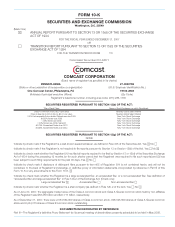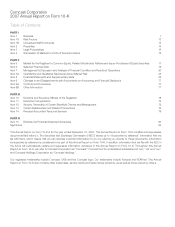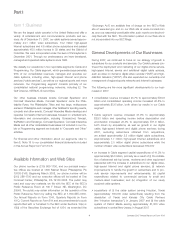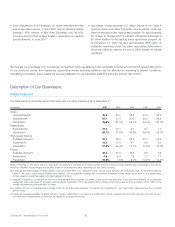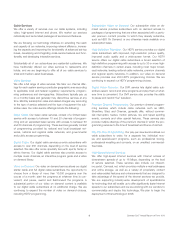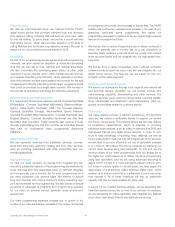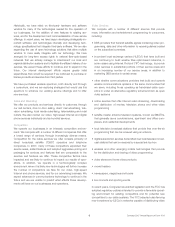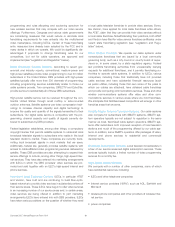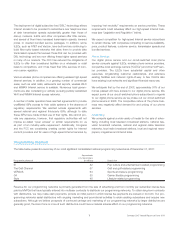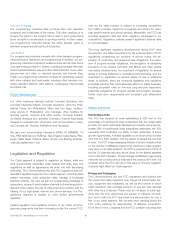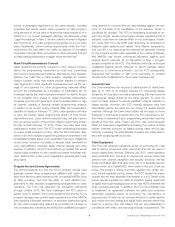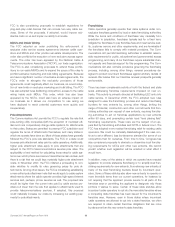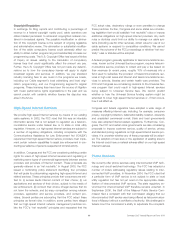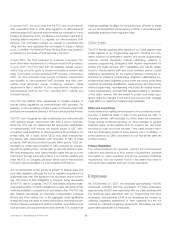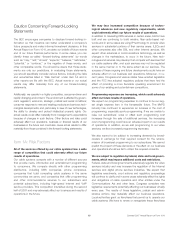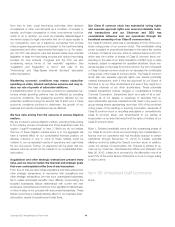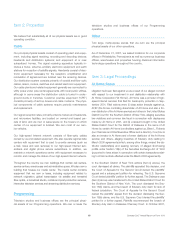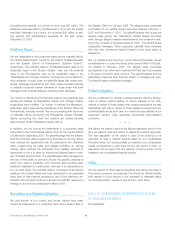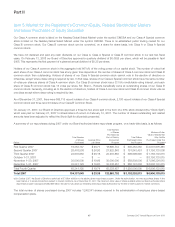Comcast 2007 Annual Report Download - page 9
Download and view the complete annual report
Please find page 9 of the 2007 Comcast annual report below. You can navigate through the pages in the report by either clicking on the pages listed below, or by using the keyword search tool below to find specific information within the annual report.
The deployment of digital subscriber line (“DSL”) technology allows
Internet access to be provided to subscribers over telephone lines
at data transmission speeds substantially greater than those of
dial-up modems. ILECs and other companies offer DSL service,
and several of them have increased transmission speeds, lowered
prices or created bundled service packages. In addition, some
ILECs, such as AT&T and Verizon, have built and are continuing to
build fiber-optic-based networks that allow them to provide data
transmission speeds that exceed those that can be provided with
DSL technology and are now offering these higher speed services
in many of our markets. The FCC has reduced the obligations of
ILECs to offer their broadband facilities on a wholesale or retail
basis to competitors, and it has freed their DSL services of com-
mon carrier regulation.
Various wireless phone companies are offering wireless high-speed
Internet services. In addition, in a growing number of commercial
areas, such as retail malls, restaurants and airports, wireless Wi-Fi
and WiMAX Internet service is available. Numerous local govern-
ments are also considering or actively pursuing publicly subsidized
Wi-Fi and WiMAX Internet access networks.
A number of cable operators have reached agreements to provide
unaffiliated ISPs access to their cable systems in the absence of
regulatory requirements. We reached access agreements with
several national and regional third-party ISPs, although to date
these ISPs have made limited use of their rights. We cannot pro-
vide any assurance, however, that regulatory authorities will not
impose so-called “open access” or similar requirements on us
as part of an industry-wide requirement. Additionally, Congress
and the FCC are considering creating certain rights for Internet
content providers and for users of high-speed Internet services by
imposing “net neutrality” requirements on service providers. These
requirements could adversely affect our high-speed Internet busi-
ness (see “Legislation and Regulation” below).
We expect competition for high-speed Internet service subscribers
to remain intense, with companies competing on service availability,
price, product features, customer service, transmission speeds and
bundled services.
Phone Services
Our digital phone service and our circuit-switched local phone
service compete against ILECs, wireless phone service providers,
competitive local exchange carriers (“CLECs”) and other VoIP serv-
ice providers. The ILECs have substantial capital and other
resources, longstanding customer relationships, and extensive
existing facilities and network rights-of-way. A few CLECs also
have existing local networks and significant financial resources.
We anticipate that by the end of 2008, approximately 91% of our
homes passed will have access to our digital phone service. We
expect some of our circuit-switched phone subscribers to migrate
to our digital phone service as we phase out our circuit-switched
phone service in 2008. The competitive nature of the phone busi-
ness may negatively affect demand for and pricing of our phone
services.
Advertising
We compete against a wide variety of media for the sale of adver-
tising, including local television broadcast stations, national tele-
vision broadcast networks, national and regional cable television
networks, local radio broadcast stations, local and regional news-
papers, magazines and Internet sites.
Programming Segment
The table below presents a summary of our most significant consolidated national programming networks as of December 31, 2007:
Programming Network
Approximate
U.S. Subscribers
(in millions) Description
E! 82 Pop culture and entertainment-related programming
The Golf Channel 67 Golf and golf-related programming
VERSUS 64 Sports and leisure programming
G4 55 Gamer lifestyle programming
Style 48 Lifestyle-related programming
Revenue for our programming networks is primarily generated from the sale of advertising and from monthly per subscriber license fees
paid by MVPDs that have typically entered into multiyear contracts to distribute our programming networks. To obtain long-term contracts
with distributors, we may make cash payments, provide an initial period in which license fee payments are waived or do both. Our pro-
gramming networks assist distributors with ongoing marketing and promotional activities to retain existing subscribers and acquire new
subscribers. Although we believe prospects of continued carriage and marketing of our programming networks by larger distributors are
generally good, the loss of one or more of such distributors could have a material adverse effect on our programming networks.
7Comcast 2007 Annual Report on Form 10-K

